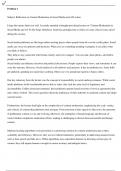Examen
Reflection on Content Moderation in Social Media and AI Lecture
- Cours
- Établissement
Reflection on Content Moderation in Social Media and AI LectureI hope this memo finds you well. I recently attended a thought-provoking lecture on "Content Moderation in Social Media and AI" by By Serge Abiteboul, which has prompted me to reflect on some critical issues raised during the session....
[Montrer plus]



